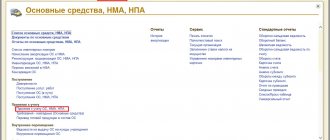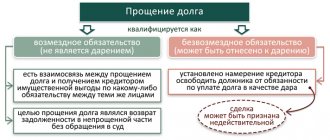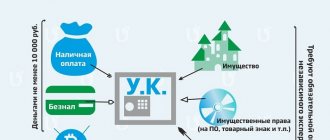The law allows the gratuitous transfer of assets from one legal entity to another. A special case of such a transfer is the provision of funds directly by the founder. This is not possible in all cases.
Let's consider what situations are legal for the founder to transfer finances without expecting any reciprocal steps or obligations, what is the meaning of this operation, how to properly formalize it and carry it out in accounting.
Question: How to reflect in the accounting of an organization the gratuitous receipt of raw materials transferred for the purpose of financial assistance to the organization by an individual who is not an individual entrepreneur and the founder of the organization? View answer
Help in kind
The participant can provide financial assistance in non-monetary form. That is, transfer fixed assets, materials, goods, and intangible assets to the organization. The accounting procedure in this case depends on the type of property. For more information, see:
- How to register and record the receipt of fixed assets free of charge;
- How to record the receipt of materials in accounting;
- How to reflect the purchase of goods in accounting;
- How to reflect the acquisition (creation) of a trademark in accounting.
Accounting for authorized capital and settlements with founders (account 80 and 75)
The first business transaction for any enterprise is the reflection of the authorized capital. Even before you registered the company, you had to decide on its size; after the company is registered, the amount of the authorized capital will appear in the constituent documents of the enterprise. Now all that remains is to correctly reflect this amount in accounting using entries.
How to contribute authorized capital with property? The property can be assessed by the founders themselves or by engaging a third-party expert. With a property value of up to 20 thousand rubles. the decision on the accounting value is made by the founders of the organization; if the value of the property is more than 20 thousand rubles, then an independent assessment by an expert is required.
Help with money
If financial assistance from a participant is received in cash, then the accounting procedure depends on the period in which it was received:
- during the reporting year - for any purpose;
- at the end of the reporting year - to cover the loss generated in account 84 “Retained earnings (uncovered loss)”.
Include the money received from the participant during the year as other income. Make a note in your accounting:
Debit 50 (51) Credit 91-1
– reflects the gratuitous receipt of money from the participant.
Do not use Account 98-2 “Gratuitous receipts” when receiving money. It is intended to account for income from gratuitous receipts of non-monetary assets only. This conclusion can be made in the Instructions for the chart of accounts.
An example of how financial assistance provided by the founder in cash is reflected in accounting
In March of this year, the founder of Alpha LLC A.V. Lvov provided financial assistance to the organization in cash. The purpose of financial assistance is to replenish the organization’s working capital, amount – 500,000 rubles. The money arrived in the organization’s bank account on March 15.
An entry was made in Alpha's accounting records.
March 15th:
Debit 51 Credit 91-1 – 500,000 rub.
– financial assistance was received from the founder.
Contributions of the founder to the current account
The founder of the enterprise can replenish the current account with cash or by wire transfer. Replenishment of the current account with cash is carried out through the cash desk of the enterprise. The founder does not have the right to directly deposit cash into current accounts, except in cases stipulated by law. The cashier must:
- Accept funds on the basis of the PKO, indicating the details of the person, amount, and basis for the contribution.
- Attach a copy of the basis document to the cash order.
- Transfer funds to your current account. When depositing cash, the purpose of the payment is important. It is necessary to exclude the definition of a contribution as revenue.
Transfer of funds from the personal account of the founder is allowed. When making a non-cash transfer, the purpose of payment of the payment order must indicate the basis for the transfer, otherwise the receipt of funds can be treated as an advance on a taxable transaction.
Loss Coverage
If money is received from a participant to repay a loss generated at the end of the reporting year, do not use account 91.
As a rule, the decision of participants, including founders or shareholders, to provide financial assistance to cover losses is made after the end of the reporting year, but before the approval of the annual financial statements. Such a decision is recognized as an event after the reporting date. Financial assistance is immediately charged to account 84 “Retained earnings (uncovered loss).” In this case, no entries are made in the accounting records of the reporting period. This follows from paragraphs 3 and 10 of PBU 7/98.
To account for incoming funds, use account 75 “Settlements with founders”. It is worth opening a subaccount for it “Funds of participants aimed at repaying losses.”
The receipt of financial assistance to cover the loss generated at the end of the reporting year should be reflected in accounting entries.
1. On the date when the decision on financial assistance is documented by the minutes of the general meeting of participants, including shareholders, or by the decision of the sole founder:
Debit 75 subaccount “Funds of participants aimed at repaying losses” Credit 84
– a decision was made to repay the loss at the expense of the participants’ funds.
2. On the date of receipt of money:
Debit 50 (51) Credit 75 subaccount “Funds of participants aimed at repaying losses”
– funds were received from participants to cover losses generated at the end of the reporting year.
This procedure follows from the Instructions for the chart of accounts (account 75).
Founder's contribution to open an account
A current account is opened after registration of the organization. At the time of opening the account, the company does not have funds received in the form of income. Payment of the bank commission is carried out at the expense of the founder. The best option to confirm the basis for the receipt of funds from the founder is a loan agreement. Funds are deposited through the company's cash desk.
The founder registered Yunost LLC. After opening, the company needed to open a bank account. The commission for opening an account was 500 rubles. Due to the lack of funds for current needs, a loan agreement was drawn up with the founder for the amount of the commission.
The following entries are made in accounting:
- The receipt of funds to the cash desk is taken into account: Dt 50 Kt 66 in the amount of 500 rubles;
- The deposit of the amount to the bank is reflected: Dt 51 Kt 50 in the amount of 500 rubles;
- The amount of the commission is taken into account as part of other expenses: Dt 91 Kt 51 in the amount of 500 rubles.
The loan is repaid from the cash desk or by bank transfer to the founder’s account.
Replenishment of the reserve fund
Situation: how to reflect in accounting the receipt of gratuitous monetary assistance from a participant (founder, shareholder) to replenish the reserve fund (capital)?
The reserve fund can only be replenished from retained earnings. Therefore, first reflect financial assistance as part of other income. At the end of the year, after summing up financial activities, include these amounts in the reserve fund.
There is no other way to form a reserve fund using financial assistance. Therefore, first reflect the funds received from participants in account 91-1 as part of other income.
Turnovers in the debit of account 91-1 “Other income” will increase the organization’s net profit generated on account 99 “Profits and losses”.
At the end of the year, after summing up the results for account 84 “Retained earnings”, form a reserve fund from retained earnings.
In accounting, reflect all this with the following entries:
Debit 50 (51) Credit 91-1
– reflects the gratuitous receipt of money from the participant (founder, shareholder);
Debit 91-1 Credit 99
– profit is reflected at the end of the year;
Debit 99 Credit 84
– reflects net profit at the end of the year;
Debit 84 Credit 82
– contributions have been made to the reserve fund (capital) according to the standards approved by the charter.
This conclusion follows from the Instructions for the chart of accounts (accounts 84, 82).
If, after increasing the reserve capital (fund), its value exceeds the restrictions established in the organization’s charter, amend the charter.
All this follows from paragraph 7 of PBU 9/99, paragraph 1 of Article 35 and Article 12 of the Law of December 26, 1995 No. 208-FZ, paragraph 1 of Article 30, paragraph 4 of Article 12 of the Law of February 8, 1998 No. 14-FZ , Instructions for the chart of accounts (accounts 84, 99) and is confirmed in the letter of the Ministry of Finance of Russia dated August 23, 2002 No. 04-02-06/3/60.
Accounting
Deposits received by an organization free of charge are included in non-operating income in accounting. This is determined by paragraph 8 of PBU 9/99 (approved by order of the Ministry of Finance of Russia dated 05/06/99 No. 32n).





